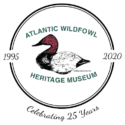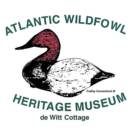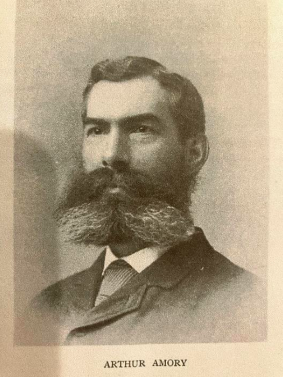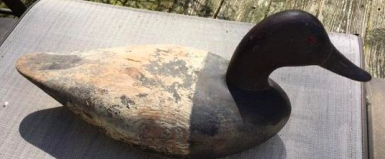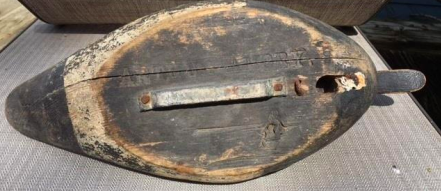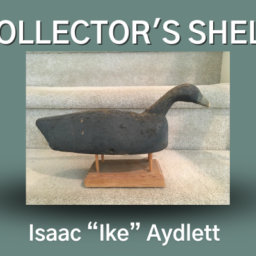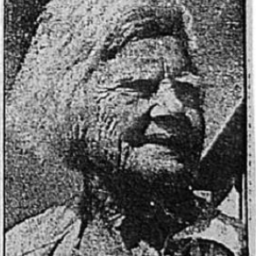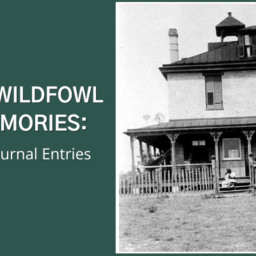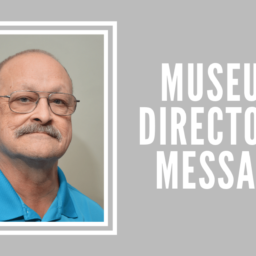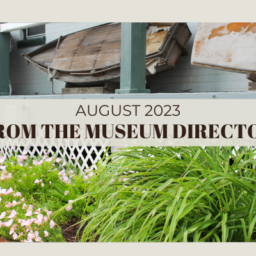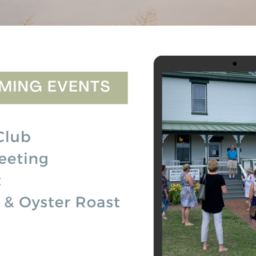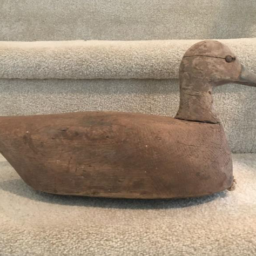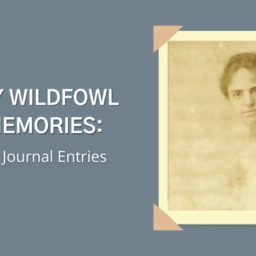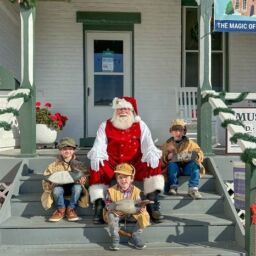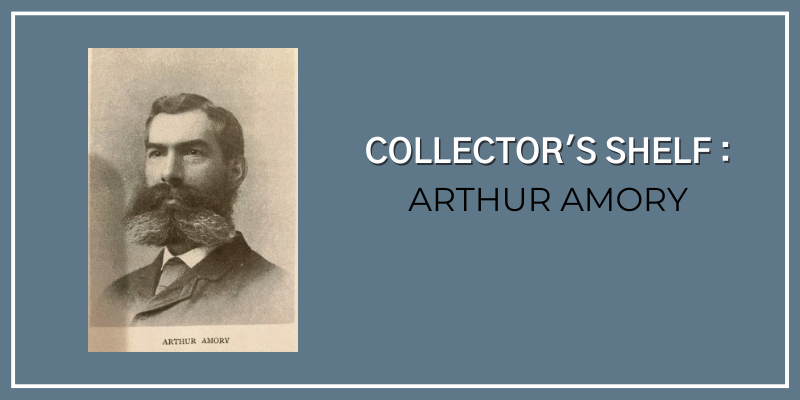
Over the next number of months, I will chronicle the fascinating history of the Lighthouse Club on Currituck Sound (Corolla, NC), through its founders and members. I will begin those installments with the story of club founder Arthur Amory, whom I perceive was a “Great Gatsby-esque” figure for this sporting and social institution. The Lighthouse Club was founded in 1874 by six sportsmen residing at the time in New York City: Arthur Amory, George Richmond Fearing, Theodore Burnett Baldwin, Charles G. Francklyn, Gilbert Russell Payson, and Charles Edward Strong. These individuals and the subsequent members of the Lighthouse Club came from prominent, wealthy families (mostly Boston families termed “Boston Brahmins”), lived notably interesting lives, and shared much in common, all of which these chronicles will reveal in these newsletters over the next several months. There is an extensive list of names and families, many of which were related by marriage, all with interesting stories of their own. They were descendants of and/or connected to original settlers of the Massachusetts Bay Colony, our country’s Founding Fathers, U.S. Presidents, other prominent politicians, and even British royalty. Most, also, were Harvard graduates and members of the Porcellian Club, that school’s most secretive and exclusive campus group, founded in 1791. Some of the “Porc Club’s” most notable members include Theodore Roosevelt and others of the Roosevelt family (but distant cousin Franklin D. was not “punched”—i.e., accepted for membership), Richard Henry Dana, Jr. (author of Two Years Before the Mast), renowned Supreme Court Justice Oliver Wendell Holmes, Jr., William Henry Fitzhugh Lee (son of Robert E. Lee and who had an interesting connection to and Civil War encounter with one of the Lighthouse Club members), Henry Cabot Lodge (congressman, senator, and diplomat), Union Gen. George Gordon Meade, and many others more renowned during their day.
Notably in more recent times, none of the Kennedy family were punched for Porc Club membership. Lighthouse Club members also were members of New York City’s exclusive gentlemen’s Union and Knickerbocker Clubs. The Union Club was founded in 1830. The Knickerbocker Club was founded in 1871 by Lighthouse Club founder Col. George Richmond Fearing who was a member of the Union Club at the time, but who faulted the Union Club for relaxing its membership standards. Nevertheless, these two exclusive clubs still exist today in New York City.
With so much to be shared regarding the Lighthouse Club’s membership, a logical beginning would be a decoy (photo attached) originally owned by club founder Arthur Amory (1841-1911). This decoy, along with several others owned by Lighthouse Club members, was acquired by Mark Cromwell as part of a considerably larger lot from an elderly gentleman whose family had hunted waterfowl on Back Bay and Currituck Sound for generations. All of these Lighthouse Club decoys have members’ names branded into the bottom and were used in the late 1800s, making them 120+ years old. However, it’s likely we would know nothing about any of them had Arthur Amory’s full name not been branded into his decoy. That decoy became the Rosetta Stone—the key to learning the owners of the other decoys (which only had a last name or an initial and last name) and the fascinating histories of the club’s founders and members.
When I acquired the Amory decoy from Mark, he suggested I research the name branded on the bottom. Eventually, I picked up my copy of Archie Johnson and Bud Coppedge’s Gun Clubs & Decoys (of Back Bay & Currituck Sound). The index revealed the name “Amory, Arthur”…and the door opened. I ultimately then made it to a publication entitled Universities And Their Sons from the 1800s. There I came upon bios of two Lighthouse Club founders: Arthur Amory and Gilbert Russell Payson (more about Payson in a subsequent installment), two Boston Brahmin 1862 Harvard graduates. Amory’s bio provided a bit about his lineage, which I will discuss in further detail below, his 1862 graduation from Harvard and membership in the Porcellian Club, a scientific expedition he made to Greenland, several other associations and club memberships, but, perhaps most notably, his membership in “…the Lighthouse Club of Currituck Sound.” It also noted that Amory founded the Harvard Club in New York City, which exists still today and is actively frequented by Harvard graduates living and working in the city. Additionally, I learned that both Amory and fellow-founder Payson were fitted for college at the Dixwell School, described as, “…the finest private school in Boston…Any graduate who bore Mr. Dixwell’s [Epes Sargent Dixwell] hallmark was sufficiently guaranteed without further question.” Between 1851 and 1872 when Mr. Dixwell retired, almost 500 of his scholars matriculated from Harvard. Amory (and Payson) was included in that number. In an interesting aside, Dixwell students in 1860 formed the Oneida Football Club, the first organized team to play what evolved into American football. This likely occurred just after Amory and Payson had moved on to Harvard.
From here, a good question to pose is, “What does Arthur Amory have to do with the Boston Tea Party, the well-known Middleton Plantation of Charleston, SC (which is actively visited today), and the telephone, among other things. Let’s start with Arthur, himself. He was born in Boston in 1841 to James Sullivan Amory (1809- 1884) and Mary Copley (Greene) Amory (1817-1892). Mary Copley Greene was the daughter of Gardiner Greene (1753-1832), a wealthy cotton planter and merchant from Boston who conducted business from Greenfield, his plantation in Demerara, Guyana (on the coast of South America between Venezuela and Brazil). In 1800, he married his third wife (the first two having predeceased him), Elizabeth Clarke Copley (1770-1866), Page | 5 whom he met in London. She was the daughter of John Singleton Copley, famous colonial-era artist, the sister of Baron Lyndhurst (Lord Chancellor of England), and was Mary Copley (Greene) Amory’s mother. Elizabeth’s grandfather was one Richard Clarke, the merchant to whom was consigned the tea destroyed in the Boston Tea Party. A great-granddaughter of Gardiner (and, therefore, distant cousin of Amory), one Mabel Gardiner Hubbard, married Alexander Graham Bell, inventor of the telephone. In 1803, Gardiner bought an estate in Boston on Cotton Hill, where he built “The most conspicuous and elegant garden [in Boston and] one of the early green-houses…with fruit and ornamental trees from foreign lands.” The garden and green-house were guarded by “…a fierce mastiff, Pedro [no doubt, a South American name], whose fur Gardiner’s daughter made into mittens!”
Establishing the connection to the Boston Tea Party and the telephone, we re-focus on Arthur, himself. As noted above, his father was James Sullivan Amory, a son of Jonathon Amory (1770-1828). In 1801, Jonathon married Mehitable (Sullivan) Amory (1772-1847), daughter of James Sullivan (1744-1808), Arthur’s father’s (James Sullivan Amory’s) namesake and Attorney General and 7th Governor of Massachusetts.
Jonathon graduated from Harvard (in 1787) and pursued a mercantile career. Jonathon (1770-1828) was the son of Thomas Amory (1722-1784) and Elizabeth (Coffin) Amory (1741-1833). Elizabeth Coffin was the cousin of Admiral Sir Isaac Coffin of the Royal Navy, which likely explains her and Thomas’s loyalist leanings during the Revolutionary War.
Thomas, Elizabeth, and her family (the Coffins) removed to Quebec during the war, before returning to Boston where Thomas rejoined the Amory family merchant business. Thomas (1722-1784) was the son of, also, Thomas Amory (1682-1728) and Rebecca (Holmes) Amory (1700- 1769). He was born in Dublin, Ireland to also another Jonathan Amory (1654-1699). That Jonathan was born at Bristol, England to also another Thomas Amory (1608-1667), one of that city’s “Merchant Adventurers,” who took the family to Ireland. From Ireland, Jonathan (1654-1699) took his family to Barbados (1683) and then on to Charleston, SC (1685), where he became Speaker of the Assembly, Advocate-General, and Public Treasurer of South Carolina. Jonathan (1654-1699) had two children, the previously-mentioned Thomas (1682-1728) and Sarah (Amory) Middleton (1690-1722), who married South Carolina Royal Governor Arthur Middleton (1681- 1737). Thomas (1682-1728) was sent to England for education, returned to Charleston, was sent on business to the Azores, and then in 1719 moved to Boston, where our decoy owner Arthur Amory (namesake from Arthur Middleton?) was a lineal descendant four generations later.
Meanwhile back in Charleston, Thomas’s sister Sarah (Amory) Middleton and Governor Arthur Middleton gave birth to Henry Middleton (1717-1784), whose first wife was Mary (Williams) Middleton (1715-1761). It was through Mary that Henry acquired the same Middleton Plantation which is a much-touted tour destination today in Charleston. Henry served as 2nd President of the Continental Congress and was one of the wealthiest landowners in the colonies, at one time possessing 20 plantations of some 50,000 acres, to include Middleton Plantation. Henry’s and Mary’s son (also) Arthur Middleton (1742-1787) was a signatory of the Declaration of Independence along with his brother-in-law South Carolina Governor Edward Rutledge.
So with Arthur Amory we begin to get a flavor for the men who founded and subsequently joined the Lighthouse Club. Much of what I have been able to learn was a result of gaining access to the daily logbook of the Lighthouse Club, which exists as an exhibit at the Whalehead Club in Corolla, NC. Again, these were socially, politically, and professionally prominent individuals with distinguished family lineages. In subsequent months, I will chronicle additional Lighthouse Club founders and members. We will see connections to the earliest colonial immigrants, prominent politicians, military leaders, Founding Fathers, U.S. Presidents, and even an English monarch. At least some of us are aware of the prominent Americans who hunted at waterfowl clubs on Back Bay and Currituck Sound. My recent research on the Lighthouse Club will demonstrate that this could arguably have been the grandest club of them all. The one decoy branded with Arthur Amory’s name made it all possible. Stay tuned.
Notably, in more recent times, none of the Kennedy family were punched for Porc Club membership. Lighthouse Club members also were members of New York City’s exclusive gentlemen’s Union and Knickerbocker Clubs. The Union Club was founded in 1830. The Knickerbocker Club was founded in 1871 by Lighthouse Club founder Col. George Richmond Fearing who was a member of the Union Club at the time, but who faulted the Union Club for relaxing its membership standards. Nevertheless, these two exclusive clubs still exist today in New York City.
With so much to be shared regarding the Lighthouse Club’s membership, a logical beginning would be a decoy (photo attached) originally owned by club founder Arthur Amory (1841-1911). This decoy, along with several others owned by Lighthouse Club members, was acquired by Mark Cromwell as part of a considerably larger lot from an elderly gentleman whose family had hunted waterfowl on Back Bay and Currituck Sound for generations. All of these Lighthouse Club decoys have members’ names branded into the bottom and were used in the late 1800s, making them 120+ years old. However, it’s likely we would know nothing about any of them had Arthur Amory’s full name not been branded into his decoy. That decoy became the Rosetta Stone—the key to learning the owners of the other decoys (which only had a last name or an initial and last name) and the fascinating histories of the club’s founders and members. When I acquired the Amory decoy from Mark, he suggested I research the name branded on the bottom. Eventually, I picked up my copy of Archie Johnson and Bud Coppedge’s Gun Clubs & Decoys (of Back Bay & Currituck Sound). The index revealed the name “Amory, Arthur”…and the door opened. I ultimately then made it to a publication entitled Universities And Their Sons from the 1800s. There I came upon bios of two Lighthouse Club founders: Arthur Amory and Gilbert Russell Payson (more about Payson in a subsequent installment), two Boston Brahmin 1862 Harvard graduates.
Amory’s bio provided a bit about his lineage, which I will discuss in further detail below, his 1862 graduation from Harvard and membership in the Porcellian Club, a scientific expedition he made to Greenland, several other associations and club memberships, but, perhaps most notably, his membership in “…the Lighthouse Club of Currituck Sound.” It also noted that Amory founded the Harvard Club in New York City, which exists still today and is actively frequented by Harvard graduates living and working in the city. Additionally, I learned that both Amory and fellow-founder Payson were fitted for college at the Dixwell School, described as, “…the finest private school in Boston…Any graduate who bore Mr. Dixwell’s [Epes Sargent Dixwell] hallmark was sufficiently guaranteed without further question.” Between 1851 and 1872 when Mr. Dixwell retired, almost 500 of his scholars matriculated from Harvard. Amory (and Payson) was included in that number. In an interesting aside, Dixwell students in 1860 formed the Oneida Football Club, the first organized team to play what evolved into American football. This likely occurred just after Amory and Payson had moved on to Harvard. From here, a good question to pose is, “What does Arthur Amory have to do with the Boston Tea Party, the well-known Middleton Plantation of Charleston, SC (which is actively visited today), and the telephone, among other things. Let’s start with Arthur, himself. He was born in Boston in 1841 to James Sullivan Amory (1809- 1884) and Mary Copley (Greene) Amory (1817-1892). Mary Copley Greene was the daughter of Gardiner Greene (1753-1832), a wealthy cotton planter and merchant from Boston who conducted business from Greenfield, his plantation in Demerara, Guyana (on the coast of South America between Venezuela and Brazil). In 1800, he married his third wife (the first two having predeceased him), Elizabeth Clarke Copley (1770-1866), Page | 5 whom he met in London. She was the daughter of John Singleton Copley, famous colonial-era artist, the sister of Baron Lyndhurst (Lord Chancellor of England), and was Mary Copley (Greene) Amory’s mother. Elizabeth’s grandfather was one Richard Clarke, the merchant to whom was consigned the tea destroyed in the Boston Tea Party. A great-granddaughter of Gardiner (and, therefore, distant cousin of Amory), one Mabel Gardiner Hubbard, married Alexander Graham Bell, inventor of the telephone. In 1803, Gardiner bought an estate in Boston on Cotton Hill, where he built “The most conspicuous and elegant garden [in Boston and] one of the early green-houses…with fruit and ornamental trees from foreign lands.” The garden and green-house were guarded by “…a fierce mastiff, Pedro [no doubt, a South American name], whose fur Gardiner’s daughter made into mittens!” Establishing the connection to the Boston Tea Party and the telephone, we re-focus on Arthur, himself. As noted above, his father was James Sullivan Amory, a son of Jonathon Amory (1770-1828). In 1801, Jonathon married Mehitable (Sullivan) Amory (1772-1847), daughter of James Sullivan (1744-1808), Arthur’s father’s (James Sullivan Amory’s) namesake and Attorney General and 7th Governor of Massachusetts. Jonathon graduated from Harvard (in 1787) and pursued a mercantile career. Jonathon (1770-1828) was the son of Thomas Amory (1722-1784) and Elizabeth (Coffin) Amory (1741-1833). Elizabeth Coffin was the cousin of Admiral Sir Isaac Coffin of the Royal Navy, which likely explains her and Thomas’s loyalist leanings during the Revolutionary War. Thomas, Elizabeth, and her family (the Coffins) removed to Quebec during the war, before returning to Boston where Thomas rejoined the Amory family merchant business. Thomas (1722-1784) was the son of, also, Thomas Amory (1682-1728) and Rebecca (Holmes) Amory (1700- 1769). He was born in Dublin, Ireland to also another Jonathan Amory (1654-1699). That Jonathan was born at Bristol, England to also another Thomas Amory (1608-1667), one of that city’s “Merchant Adventurers,” who took the family to Ireland. From Ireland, Jonathan (1654-1699) took his family to Barbados (1683) and then on to Charleston, SC (1685), where he became Speaker of the Assembly, Advocate-General, and Public Treasurer of South Carolina. Jonathan (1654-1699) had two children, the previously-mentioned Thomas (1682-1728) and Sarah (Amory) Middleton (1690-1722), who married South Carolina Royal Governor Arthur Middleton (1681- 1737). Thomas (1682-1728) was sent to England for education, returned to Charleston, was sent on business to the Azores, and then in 1719 moved to Boston, where our decoy owner Arthur Amory (namesake from Arthur Middleton?) was a lineal descendant four generations later. Meanwhile back in Charleston, Thomas’s sister Sarah (Amory) Middleton and Governor Arthur Middleton gave birth to Henry Middleton (1717-1784), whose first wife was Mary (Williams) Middleton (1715-1761). It was through Mary that Henry acquired the same Middleton Plantation which is a much-touted tour destination today in Charleston. Henry served as 2nd President of the Continental Congress and was one of the wealthiest landowners in the colonies, at one time possessing 20 plantations of some 50,000 acres, to include Middleton Plantation. Henry’s and Mary’s son (also) Arthur Middleton (1742-1787) was a signatory of the Declaration of Independence along with his brother-in-law South Carolina Governor Edward Rutledge. So with Arthur Amory we begin to get a flavor for the men who founded and subsequently joined the Lighthouse Club. Much of what I have been able to learn was a result of gaining access to the daily logbook of the Lighthouse Club, which exists as an exhibit at the Whalehead Club in Corolla, NC. Again, these were socially, politically, and professionally prominent individuals with distinguished family lineages. In subsequent months, I will chronicle additional Lighthouse Club founders and members. We will see connections to the earliest colonial immigrants, prominent politicians, military leaders, Founding Fathers, U.S. Presidents, and even an English monarch. At least some of us are aware of the prominent Americans who hunted at waterfowl clubs on Back Bay and Currituck Sound. My recent research on the Lighthouse Club will demonstrate that this could arguably have been the grandest club of them all. The one decoy branded with Arthur Amory’s name made it all possible. Stay tuned.
